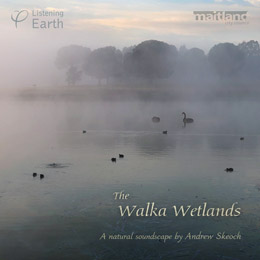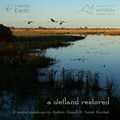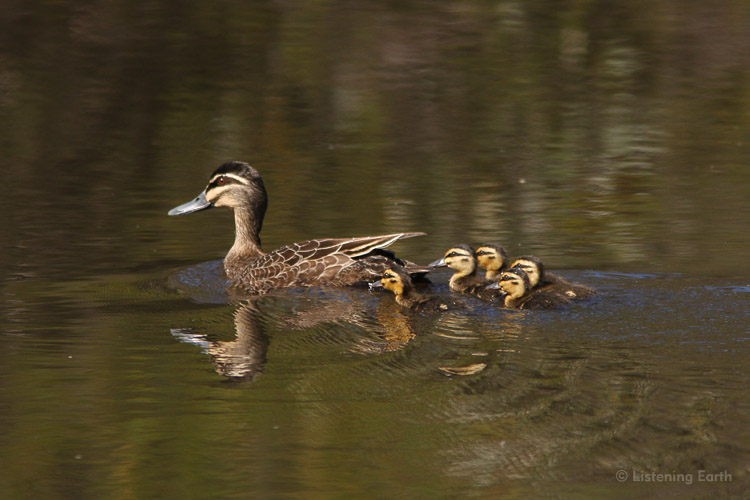

Running Time:
157 min
Release Date:
September 2019
Recording Location:
Walka Lake, Maitland, NSW
The Walka Wetlands
Walka Lake is situated on the edge of the rural city of Maitland. A reservoir surrounded by parks and bushland, it is a haven for waterfowl and native birdlife, and this recording takes us through a day by its shoreline.
Throughout the night, a community of tiny Crinia froglets have been chorusing from reedbeds surrounding the lake. As the first light of dawn enters the sky, a pair of Black Swans bugle gently as they float on the still waters, the wings of waterfowl whistle overhead, and the calls of ducks echo off the treeline.
From surrounding bushland, the dawn chorus begins with kookaburras, magpies, honeyeaters, whistlers, robins and spinebills. As the morning warms up, flocks of silvereyes and yellow thornbills move through the tree canopy, while fantails flutter acrobatically and fairy-wrens trill from the undergrowth.
Meanwhile, coots dabbling near the shore occasionally erupt in an agitation of splashing and explosive calls. Ravens, lorikeets, galahs and black cockatoos can be heard occasionally as they wing over the lake, and a grey shrike thrush gives a virtuosic display of subsong nearby.
By late morning, a breeze has sprung up, stirring the foliage of the casuarinas lining the shore. At this point, we take a midday break, and listen instead to the life under the waters of the lake itself, a secret soundscape of tiny aquatic insects.
We return in the late afternoon, as birds give their last calls of the day. A white-faced heron barks wheezily as it flaps past, and as the light fades, the crinia froglets again begin their nocturnal chorus. With dusk, everything settles down, except the coots, which indulge in a last flurry of commotion out on the still waters.
Andrew comments:
"This recording was made as a commission from Maitland City Council. Their project, focused around an app, utilises audio to educate about the site to visitors and local residents, and communicate its natural values. As a nature sound person, I'm encouraged when projects like this are initiated by people who can appreciate how evocative sound and listening can be.
"I had four days in which to work, and utilising three recording rigs, collected recordings from different locations around the lakeshore, both throughout the night and day. I also employed a pair of hydrophones to gather recordings of aquatic insects from below the water.
"Walka Lake is a man-made reservoir, constructed in the 1880s to supply safe drinking water to the lower Hunter Valley. Although the functioning Water Works was decommissioned in the late 1920s, the lake has remained a refuge for waterfowl ever since. More recently, the City Council has embarked on extensive restoration of the surrounding bushland, removing weeds and replanting with native trees and shrubs.
"When visitors come to the lake today, they find a picturesque location which is home to the diversity of waterfowl and birdlife heard on this recording.
"My focus was to both highlight the healthy community of bush birds that has resulted from revegetation works, and at the same time, capture the activity of waterfowl on the lake itself.
"Being close to Maitland city, and with a rail line passing by the perimeter, the drift of urban noise was an issue. However by using the topography of the site when placing my microphones, and with favourable weather, I ended up with many hours of material. With selective editing and careful processing in the studio, I'm very pleased with the results."
Audio sample of this album
|
1. |
Pre-dawn: Crinia signifera Frogs |
1.44 |
|
2. |
Black Swans |
1.53 |
|
3. |
Pacific Black Ducks |
2.59 |
|
4. |
First Light: Magpies and Kookaburras Begin the Dawn Chorus |
2.19 |
|
5. |
Blackbird Song |
7.44 |
|
6. |
Australian Raven |
6.17 |
|
7. |
Sunrise: Silvereyes |
3.07 |
|
8. |
Golden Whistler |
1.07 |
|
9. |
Magpie Larks |
2.10 |
|
10. |
Grey Fantail |
10.14 |
|
11. |
Morning: Yellow-faced Honeyeater |
6.48 |
|
12. |
Red-browed Finch |
0.16 |
|
13. |
Yellow Thornbills |
3.53 |
|
14. |
Eastern Yellow Robin |
1.37 |
|
15. |
Galahs |
1.13 |
|
16. |
Reed Warbler |
3.17 |
|
17. |
White-browed Scrubwren |
0.58 |
|
18. |
Masked Lapwing |
7.18 |
|
19. |
Red Wattlebird |
1.48 |
|
20. |
Superb Fairy-wren |
2.24 |
|
21. |
Later Morning: Grey Shrike Thrush |
17.13 |
|
22. |
Black-faced Cuckoo-shrike |
2.20 |
|
23. |
Fuscous Honeyeater |
1.44 |
|
24. |
Spotted Pardalote |
1.54 |
|
25. |
Crimson Rosellas |
2.35 |
|
26. |
Yellow Thornbills - The Party Returns |
0.31 |
|
27. |
Eastern Spinebill and White-naped Honeyeaters |
3.06 |
|
28. |
Spotted Turtledoves |
1.04 |
|
29. |
Wind in the Casuarinas |
5.24 |
|
30. |
Yellow-tailed Black Cockatoo |
2.11 |
|
31. |
Midday Interlude: Aquatic Insects in Walka Lake |
17.25 |
|
32. |
Late Afternoon: Coots on the Water |
0.52 |
|
33. |
Rainbow Lorikeets |
4.49 |
|
34. |
Eastern Spinebills in Flight |
3.56 |
|
35. |
Dusk: White-faced Heron |
3.06 |
|
36. |
Australian Magpie |
4.11 |
|
37. |
Grey Butcherbird |
3.56 |
|
38. |
Evening: A Commotion of Coots |
9.48 |
|
39. |
Wood Ducks |
1.33 |
Purchase this
album as:
Digital Album
(for immediate download)
Download this album
for as little as
$7.50 -
View Special Deals
(Prices AU$, exGST)
Mp3:
Mp3 is a universal audio format, playable on iPods, computers, media players and mobile phones.
Mp3 is a compressed format, allowing smaller filesizes, offering faster download times and requiring less storage space on players, but at some expense to the audio quality. Many listeners can't really hear the difference between mp3 and full CD-quality audio, and hence its convenience has lead to it becoming the default option for audio.
Our albums are generally encoded at around 256kbps (sometimes with VBR), balancing optimal audio quality without blowing out filesizes excessively. We encode using the Fraunhoffer algorithm, which preserves more detail in the human audible range than the lame encoder.
Our mp3 files are free of any DRM (digital rights management), so you can transfer them to any of your media technology. You've paid for them, they're yours for your personal use without restriction.
Mp3 files can be burned to disc, either as an mp3 disc, or an audio CD after converting them to a standard audio (.wav or .aif) format first.
FLAC:
FLAC is a high-quality audio format, allowing CD-resolution audio. It is ideal if you wish to burn your files to a CDR, or listen over a high resolution audio system. However files usually require special decoding by the user before playing or burning to disc.
FLAC (Free Lossless Audio Codec) is a LOSSLESS compressed audio format. This means that it preserves the full audio quality of a CD, but optimises the filesize for downloading. Typically, file sizes of around 60% are achieved without any degradation or loss of audio quality from the source files at the CD standard of 16bit/44.1kHz.
Obviously the file sizes are larger than for the mp3 version - usually around 300-400Mb for an album, compared to 100Mb for an mp3 album.
In addition, you'll need to know what to do with the files once you've downloaded them. In most cases you'll want to decode the files to wav or aiff, either to import into programs like iTunes, or burn to CDR. Some programs will play flac files natively.
There is a lot of information about flac online (eg: http://flac.sourceforge.net/)





 Alternate audio link
Alternate audio link 